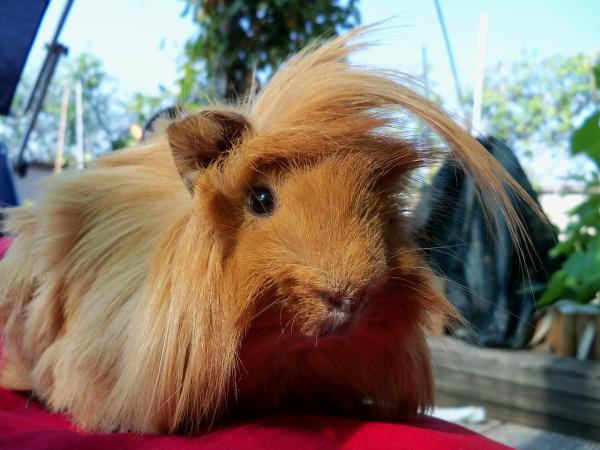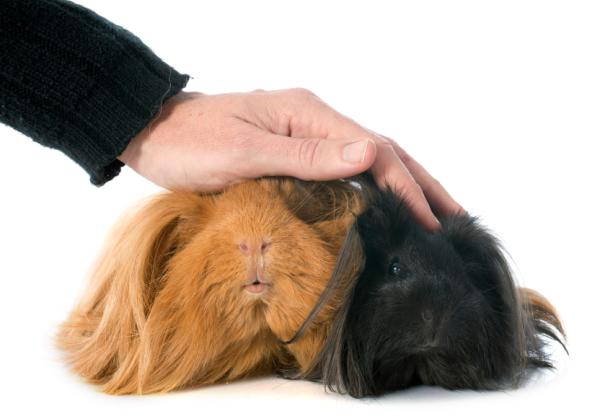
Our first interesting fact about Peruvian guinea pigs is that they are not pigs, they are not from Guinea and they may not even be Peruvian. One of the oldest guinea pig breeds, the Peruvian guinea pig still has their wild cousins roaming across many parts of South America, not just Peru. They are just as likely to be found in some parts of Brazil, Bolivia, Uruguay or Argentina. Peruvian guinea pigs should be recognizable thanks to the long hair which drapes around their little rodent bodies. It is perhaps this flowing fur which makes it one of only four guinea pig breeds allowed onto the table at breed shows. Keep reading AnimalWised for some more interesting Peruvian guinea pig facts so you can know if this is the pet for you.
Facts about Peruvian guinea pig fur
While the long fur of a Peruvian cavy (another word for guinea pig) is quite beautiful, it is not the only breed to sport it. Perhaps the two most commonly confused guinea pig breeds are the Peruvian guinea pig and the Silkie guinea pig. This is because they are both long haired guinea pigs which often look like each other, especially while they are young.
However, Peruvian guinea pigs have a couple of unique differences from the Silkie guinea pig:
- Peruvian guinea pigs have a 'rosette' of fur on the top of their head. This grows at the same length as the hair on its body giving it bangs which need to be trimmed to allow the little pig to see.
- The Peruvian guinea pig has hair which grows much longer than the Silkie. It radiates out from its body, looking like a big circle of hair if it is not trimmed.
- The Silkie guinea pig grows its hair evenly from the back of its head, so its face is not hidden like the Peruvian.
- Peruvian cavies have hair which parts down the middle.
These characteristics are visible enough to be able to tell the difference between a Peruvian guinea pig and a Silkie if you know what to look for. Thanks to the even growth of long hair, the Peruvian guinea pig has something else which is difficult to determine: which way round it is. If you do not trim a Peruvian guinea pig's bangs, then not only can it not see well, but you will find it difficult to tell which end is which.
When they are young, Peruvian cavies are often confused with Abyssinian guinea pigs. This is because they both have fur which grows long, but the Abyssinian soon grows into shorter tufts which have rosettes all over their body. This gives them a punk rock style of fur in comparison to the hair metal style of the Peruvian's long locks.

Facts about Peruvian guinea pig size
Apart from its long hair, the Peruvian cavy has a body similar to most other guinea pigs. Here are some facts about body size and characteristics:
- When they reach adult size, Peruvian guinea pigs grow to between 10 - 14 inches.
- They usually weigh between 1 - 3 pounds.
- Their normal body temperature is around 101 - 104 ºF (38 - 40 ºC).
- Their teeth are 'open rooted', this means they never stop growing.
- They have small ears and are tailless.
- Peruvian guinea pig teeth (like all guinea pigs) have only incisors at the front, two at the top and two at the bottom. They have 20 teeth in total, the other 16 being made up of molars for chewing.
Peruvian guinea pigs are prone to similar diseases as other guinea pigs such as scurvy, lice infestation and diarrhea. Scurvy is a particular concern as they can't synthesize vitamin C, meaning they need to get enough of it from their food. This is one of the reasons Peruvian guinea pigs need fresh fruit and vegetables, unable to survive on hay alone. The Peruvian guinea pig life span is around 6 to 8 years, depending on its habitat and genetic predisposition.

Facts about Peruvian guinea pig behavior
Most guinea pigs have shorter hair and will perform social grooming whereby they lick and clean each other. They actually secrete a milky fluid from their eyes which other guinea pigs lap up and use to clean another's fur.
Peruvian guinea pigs, however, cannot groom in the same way due to the sheer length of their fur. This means they cannot quite partake in the same style of social grooming. Instead, they often do something called 'barbering'. This is when the guinea pig chews the hair of other guinea pigs, often removing it at the same time.
Other types of guinea pig perform barbering for many reasons. Sometimes it is because they lack other items to chew and shorten their teeth. Males often do it as an act of dominance over other males. However, few of them do it for cosmetic effect, but some Peruvian guinea pigs have been known to barber or chew the hair at the front of another's head. This could possibly be a way they maintained vision in the wild.
This is one of the main reasons pet owners of Peruvian guinea pigs need to take grooming into consideration when deciding to live with these cavies. Peruvian cavies need to be groomed almost daily as their fur is so long, it can get matted and dirty easily. Similarly, their habitat needs to be considered as smaller hay and dusty bedding can get stuck in their long fur.

Miscellaneous Peruvian guinea pig facts:
- Peruvian guinea pig hair can grow up to 20" long on its overcoat and up to 7" long in its undercoat.
- Peruvian cavies can be monochrome, bicolor or tricolor, many people believing the tricolor to be most desirable.
- They are prone to something called 'heat stress' meaning they get uncomfortable in warmer climes thanks to their long hair.
- Peruvian guinea pigs shed all year round, but they renew their coats in the spring and fall.
- Guinea pigs often eat their own feces, mainly because they need a lot of vitamins and nutrients, something found in certain types of pellet droppings.
- Peruvian guinea pigs are a very social breed, so they fair best when housed with others.
- These long haired little beauties love being petted and groomed (carefully and lovingly) by their human owners.
Peruvian guinea pigs need a little more attention than most other breeds of guinea pig, mainly due to their long hair. They need to be groomed every day and their bedding needs to be cleaned regularly, if not also daily. However, all this time you spend with your guinea pig will just bring you closer together. They will be very happy cavies if they get the attention they deserve.
If you want to read similar articles to Peruvian Guinea Pig Facts, we recommend you visit our Facts about the animal kingdom category.